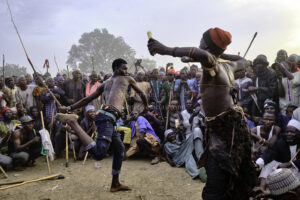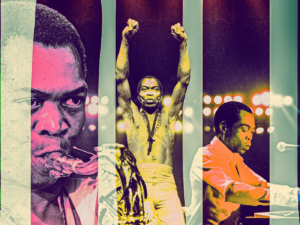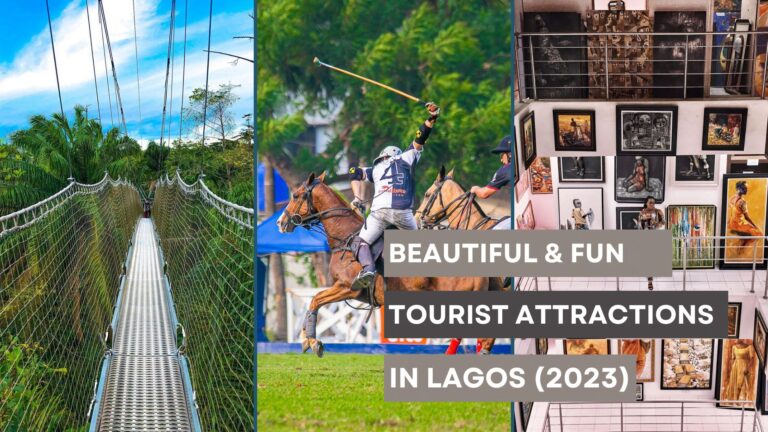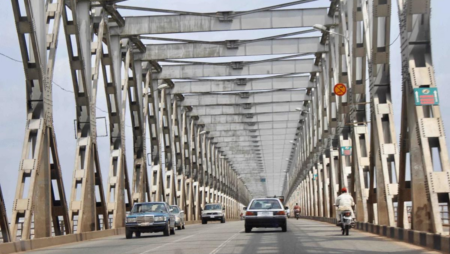Table of Contents
Discover the best of Lagos and explore its vibrant culture, captivating history, beautiful beaches, and these tourist attractions in Lagos, Nigeria. From majestic monuments to modern marvels like Eko Atlantic City; Nigeria’s largest city is packed with unforgettable experiences in store for everyone.
So join us as we take a look at ten must-see places that offer something special – each one more amazing than the last! Blast off on an adventure into this bustling metropolis full of life just waiting to be explored – start your journey today by learning about these top tourist destinations in Lagos.
1) Kalakuta Republic Museum
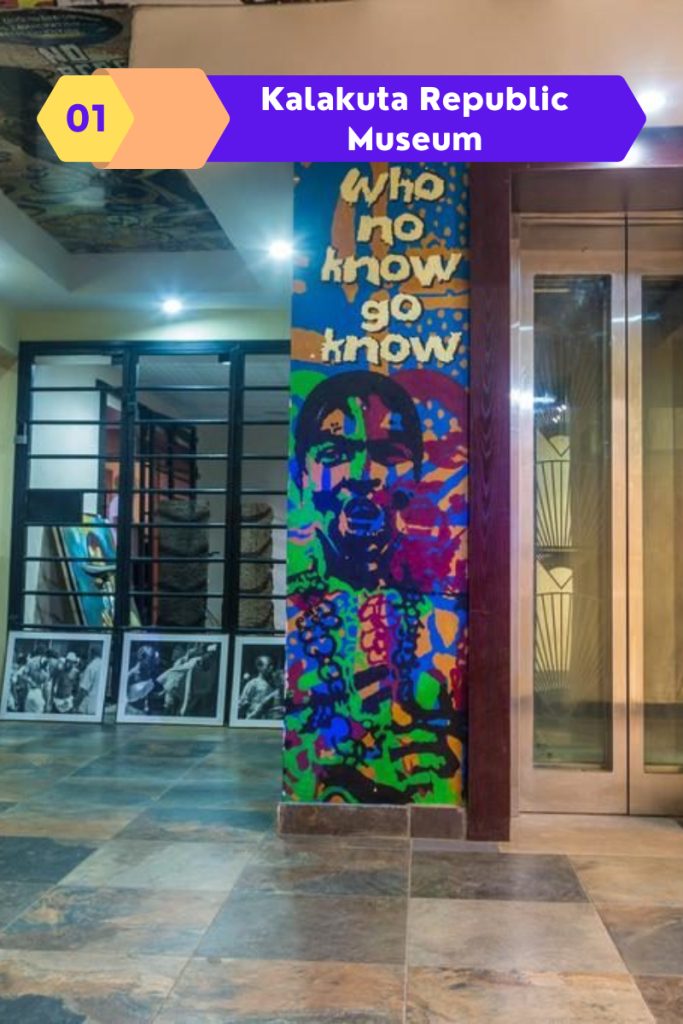
Visit the Kalakuta Republic Museum for a unique and educational experience. This former home of Afrobeat legend and human rights advocate Fela Kuti is now a museum, showcasing his life and work. Learn about the fascinating culture of Lagos through displays that pay tribute to Fela’s music, as well as traditional Yoruba sculptures, rare artifacts, photographs, and more.
F.A.Q about Kalakuta Republic
where is Kalakuta Republic
It’s located at 7 Gbemisola St, Allen 100281, Ikeja, Lagos
What are the admission fees for Kalakuta Museum?
Experience the wonders of this museum for just 1000 naira! Get a taste of culture and browse its ground floor souvenir shop. Thirsty visitors can take in panoramic views with their beverage of choice from the rooftop bar, while also having access to delicious food and palm wine selections – all available at an additional fee.
What is the meaning of Kalakuta in Nigeria?
Kalakuta is a word that has a few different meanings in Nigeria. It is the name of a former commune in Lagos, Nigeria, that was established in the 1970s by the late Nigerian musician Fela Kuti. The commune was a hub of countercultural activity and was seen as a symbol of resistance to the Nigerian government and societal norms.
The word “Kalakuta” itself is derived from the Hausa language, and it means “roughneck” or “rascal.” It was used as the name of Fela Kuti’s commune as a way to challenge societal norms and to celebrate individuality and self-expression.
2) Tarkwa Bay Beach
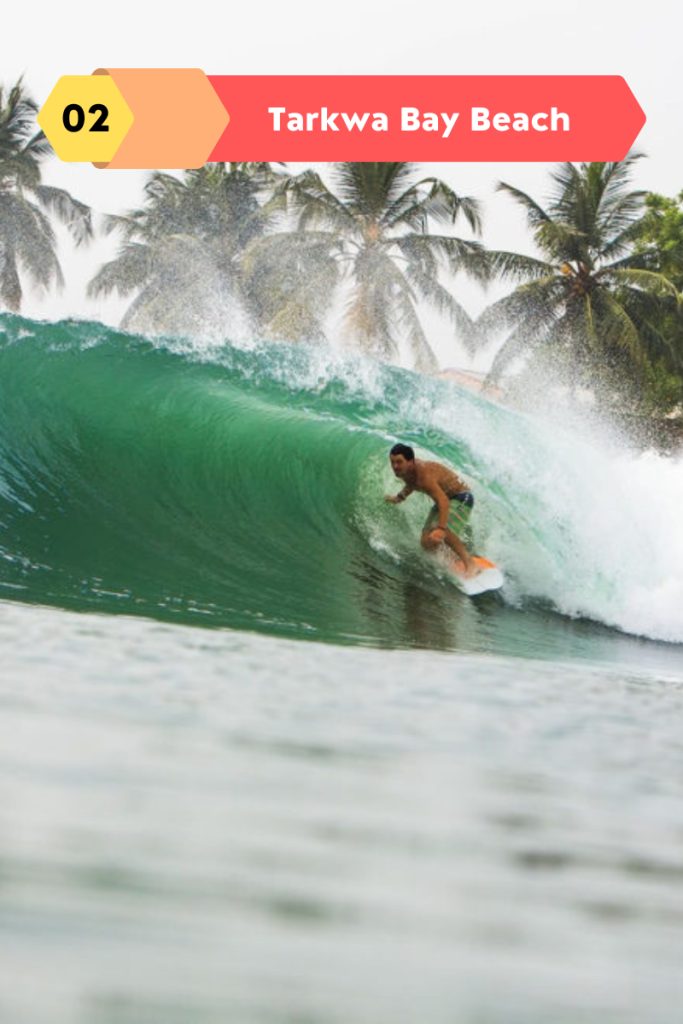
Tarkwa Bay Beach is a beautiful strip of sand located on an offshore island off the coast of Lagos. Surrounded by crystal blue waters and lined with palm trees, this destination is perfect for swimming, sunbathing, or just relaxing. There’s plenty to do here, from kayaking and stand-up paddle boarding to exploring the ruins of an abandoned fort (built in the early 19th century). The best part? Accessing this beach is easy––just hop on a ferry from Victoria Island!
F.A.Q about Tarkwa Bay Beach
What is the entrance fee to Tarkwa Bay Beach?
The gate fee for Tarkwa bay beach is 300 naira.
Can I bring food to Tarkwa Bay Beach?
Unlike most beaches like Landmark Beach, you are allowed to bring your own food. You can also find refreshments at Tarkwa Bay beach.
How do you get to Tarkwa Bay?
Tarkwa Bay is only accessible by boat. Boat rides to Tarkwa Bay can be found at Mekwe Jetty, Tarzan Marine, and Marina
3) Freedom Park
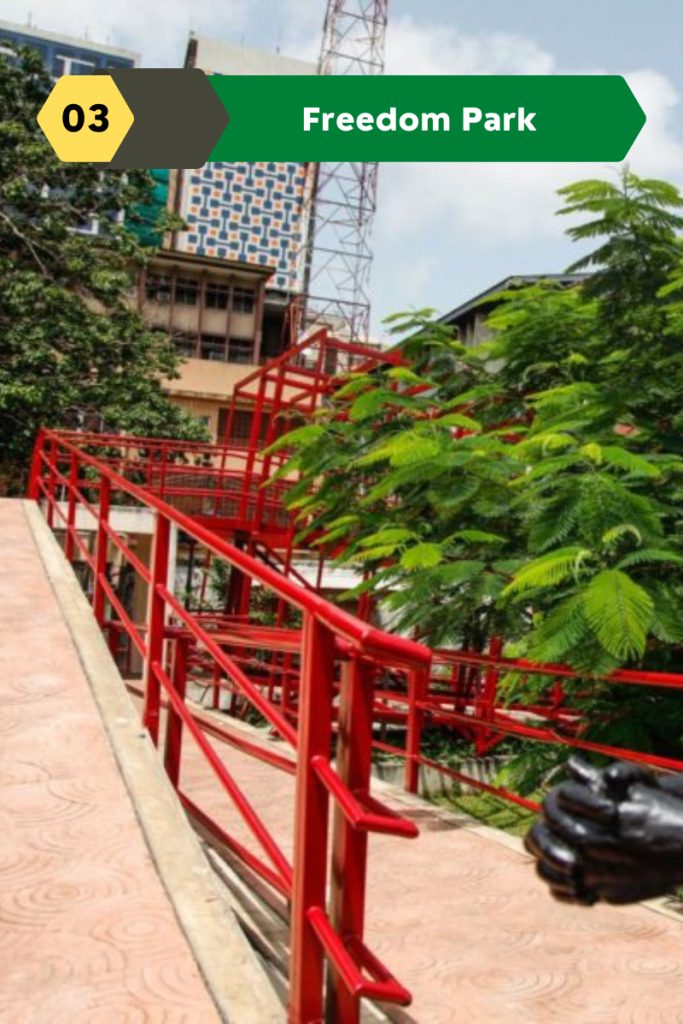
Located in the city center, Freedom Park is a bustling entertainment spot and one of Lagos’ most popular tourist attractions. Originally built in slave quarters, it has been transformed into an art-filled ambience that celebrates African heritage. Explore the park’s three-storey hall where live performances take place, or relax with some street food at the outdoor cafes and restaurants. Come here to listen to stories told by local professionals who have experienced the unique culture of Nigeria firsthand.
F.A.Q about freedom park
What is the history of Freedom Park?
Freedom Park was originally established as a colonial prison in the late 19th century. It was used to detain political prisoners during the colonial era and later served as a military detention center during the military dictatorship of the 1970s. In 2007, the park was converted into a cultural center and opened to the public as a tribute to the struggles and triumphs of the people of Nigeria.
Is Freedom Park open to the public?
Yes, Freedom Park is open to the public. It is open from Monday to Sunday, from 9:00 AM to 6:00 PM.
How do I get to Freedom Park?
Freedom Park is located in Lagos Island, Lagos, Nigeria. It can be reached by car or public transportation. There are also taxi and car hire services available to take visitors to the park.
4) Nike Art Gallery
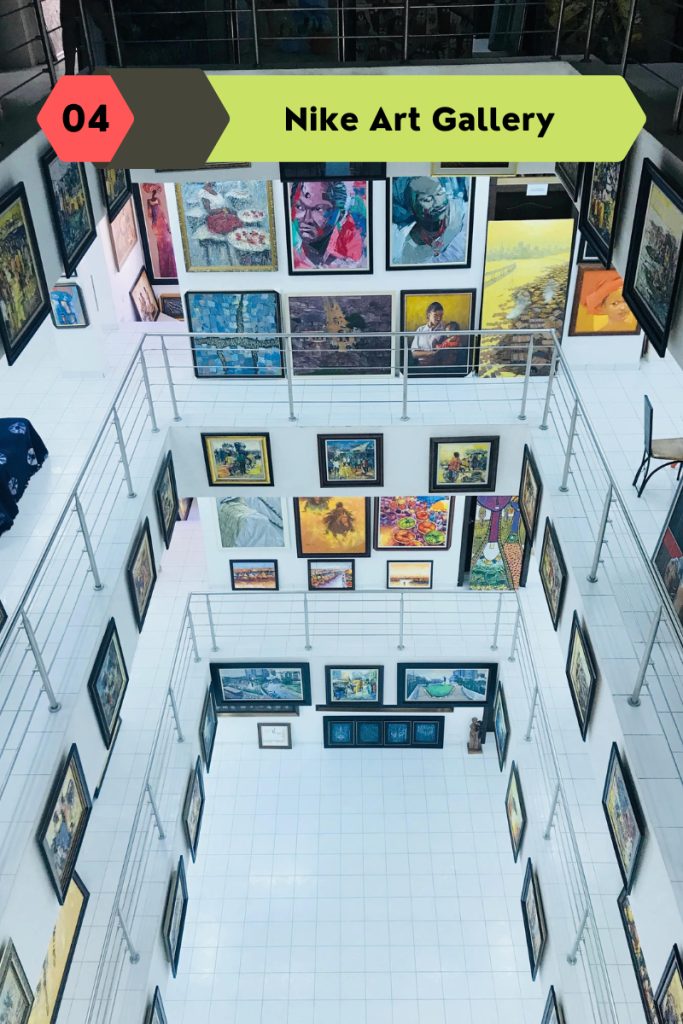
Explore Africa’s vibrant art scene at the Nike Art Gallery, located just a few minutes away from Freedom Park. Founded by famous Nigerian artist Chief Nike Okundaye in 2002, the gallery is home to over 7,500 masterpieces from some of the brightest talents in Nigeria and from around the world. Take a tour of this unique establishment and marvel at the painted wood carvings, beaded sculptures, clay figures, and fabric reliefs. Afterwards treat yourself to some traditional Nigerian food at one of the many nearby eateries.
F.A.Q about NIKE ART GALLERY
Who is the owner of Nike Art Gallery?
Chief (Mrs.) Nike Monica Okundaye popularly known and called “MAMA NIKE”
Is there an entry fee for Nike Art Gallery?
The galleries are free to enter for individual visits without a guided tour. The guided tour of the Galleries is charged at N2,000.00 per person for groups of 10 or more.
Are you allowed to take pictures at the Nike Art Gallery?
No!
5) Lekki Conservation Centre
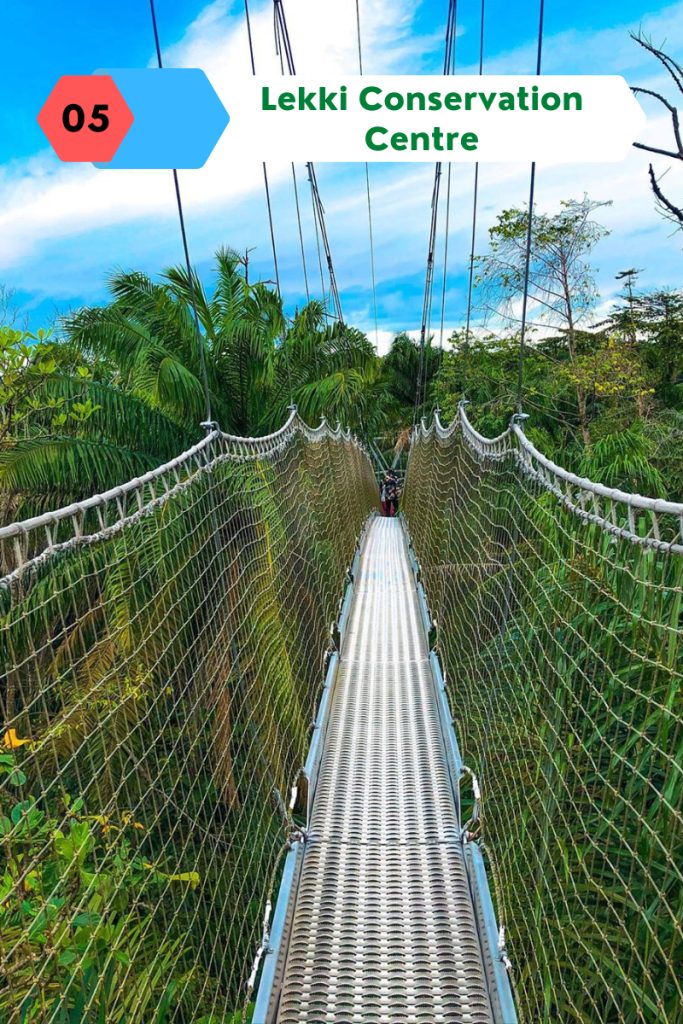
Experience the wonderful outdoors with a visit to the Lekki Conservation Centre. This protected area is home to lush, beautiful forests and diverse wildlife, making it an ideal spot for nature lovers, joggers and picnics! Get up close and personal with different species of animals such as monkeys, antelopes, snakes, exotic birds and butterflies. Take a boat ride at sunset or sunrise where you can witness breathtaking views of man-made lakes, lagoons and wetlands – a sight that is sure to stay etched in your memory forever.
F.A.Q about Lekki Conservation Centre
What are the hours of operation for the Lekki Conservation Centre?
The Lekki Conservation Centre is open daily from 8:00am to 6:00pm.
Is there an admission fee to visit the Lekki Conservation Centre?
Yes, there are guided tours available at the Lekki Conservation Centre. These tours are led by trained guides who can provide information about the flora and fauna of the area, as well as the history and cultural significance of the conservation centre.
Are there any restrictions on what visitors can bring into the Lekki Conservation Centre?
Visitors are not allowed to bring any food or drink into the Lekki Conservation Centre, with the exception of water bottles. Visitors are also not allowed to bring pets or any other animals into the conservation centre.
Is the Lekki Conservation Centre accessible to people with disabilities?
The Lekki Conservation Centre is generally accessible to people with disabilities, although some areas may be more difficult to access. It is recommended that visitors with disabilities contact the conservation centre in advance to discuss any specific accessibility needs.
6) Lagos National Museum
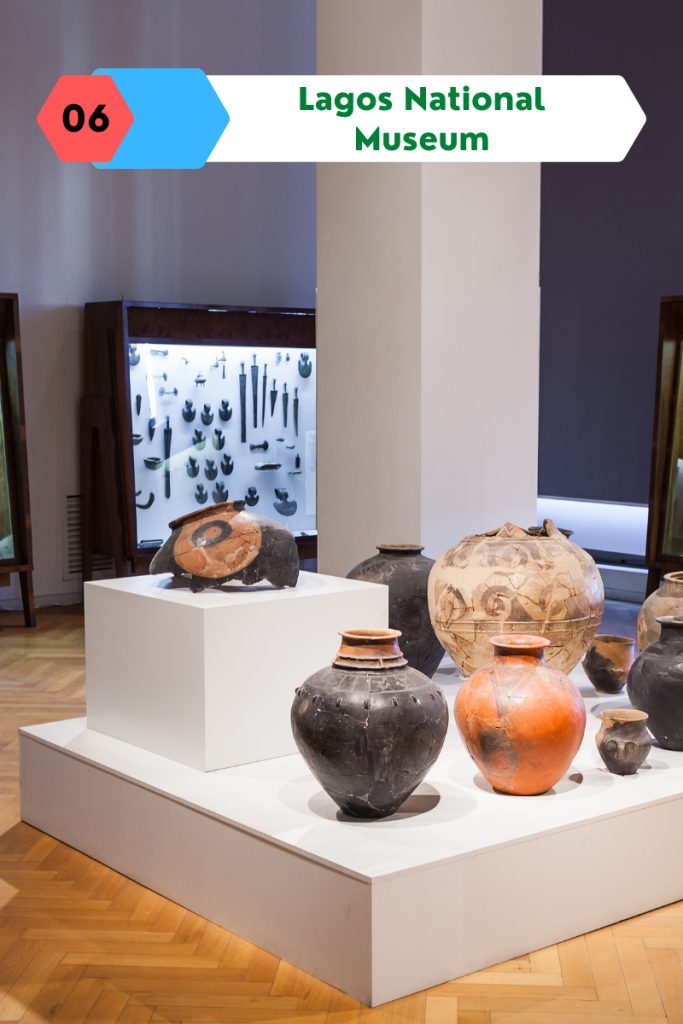
Located in the centre of Lagos, Lagos National Museum is a great place to learn and appreciate Nigeria’s culture, history and traditional artefacts. Inside you’ll find ancient coins, Tribal drums and sculptures that date back as far as 1000 years. It’s an excellent way to learn more about Nigeria’s rich culture and traditions – it’s even home to the famous bronze Benin mask!
F.A.Q about Lagos National Museum
What are the hours of operation for the Lagos National Museum?
The Lagos National Museum is open daily from 9:00am to 5:00pm, except on public holidays.
Is there an admission fee to visit the Lagos National Museum?
Yes, there is an admission fee to visit the Lagos National Museum. The cost varies depending on the age of the visitor and whether they are a Nigerian citizen or an international visitor. Children under the age of 3 years old are admitted for free.
Are there guided tours available at the Lagos National Museum?
Yes, there are guided tours available at the Lagos National Museum. These tours are led by trained guides who can provide information about the exhibits and the history and cultural significance of the museum.
7) The Point of No Return
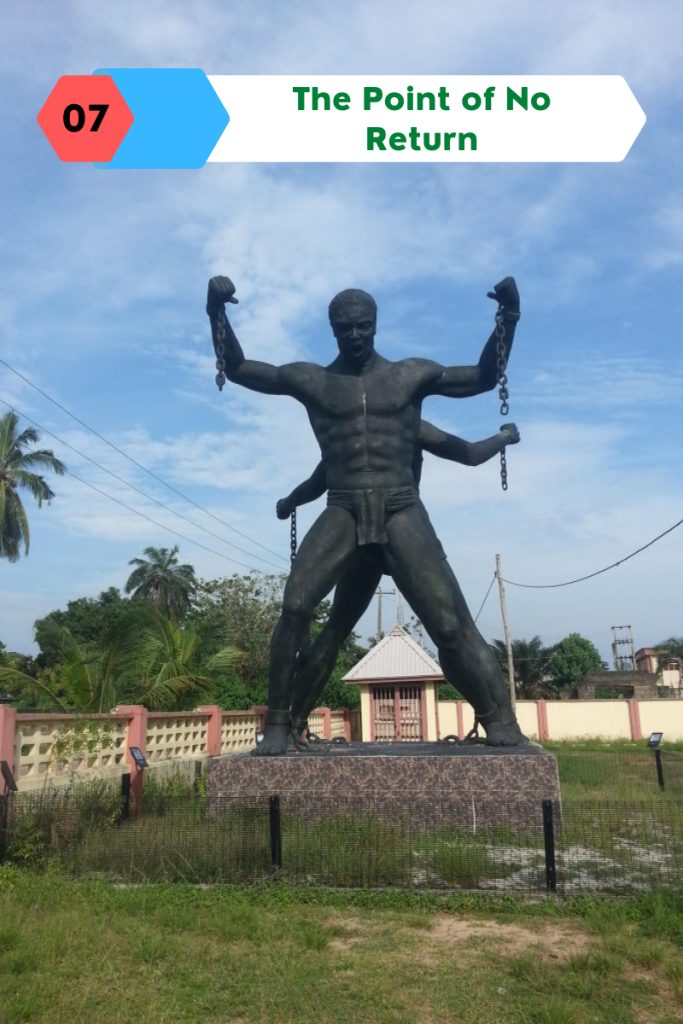
Another must-visit attraction in Lagos is The Point of No Return, located in Badagry. This remarkable monument marks the point where African slaves were taken from with its iconic iron chain. Although this place symbolises a great tragedy, it’s one of the most significant tourist attractions in Nigeria and a spot you shouldn’t miss if you’re a history buff. Take some time to learn about this thrilling yet regretful part of Nigerian culture.
F.A.Q about The Point of No Return
What is the history of The Point of No Return in Badagry?
The Point of No Return in Badagry marks the location where enslaved Africans were taken from the mainland to be transported across the Atlantic Ocean during the transatlantic slave trade.
It is believed that this site was used as a major embarkation point for slaves during the 19th century, with as many as 500,000 people being forced to leave Africa through this point.
Is The Point of No Return open to the public?
Yes, The Point of No Return in Badagry is open to the public. It is a popular tourist destination and is visited by many people each year.
Is there any food or drink available at The Point of No Return in Badagry?
There may be food and drink available at The Point of No Return in Badagry, although this can vary depending on the time of year and the availability of vendors. It is generally recommended to bring water and snacks if you are planning to visit the site, as it may not be possible to purchase food or drink onsite.
Is The Point of No Return a suitable destination for children?
The Point of No Return may be suitable for children, depending on their age and maturity level.
8) The Lagos Polo Club
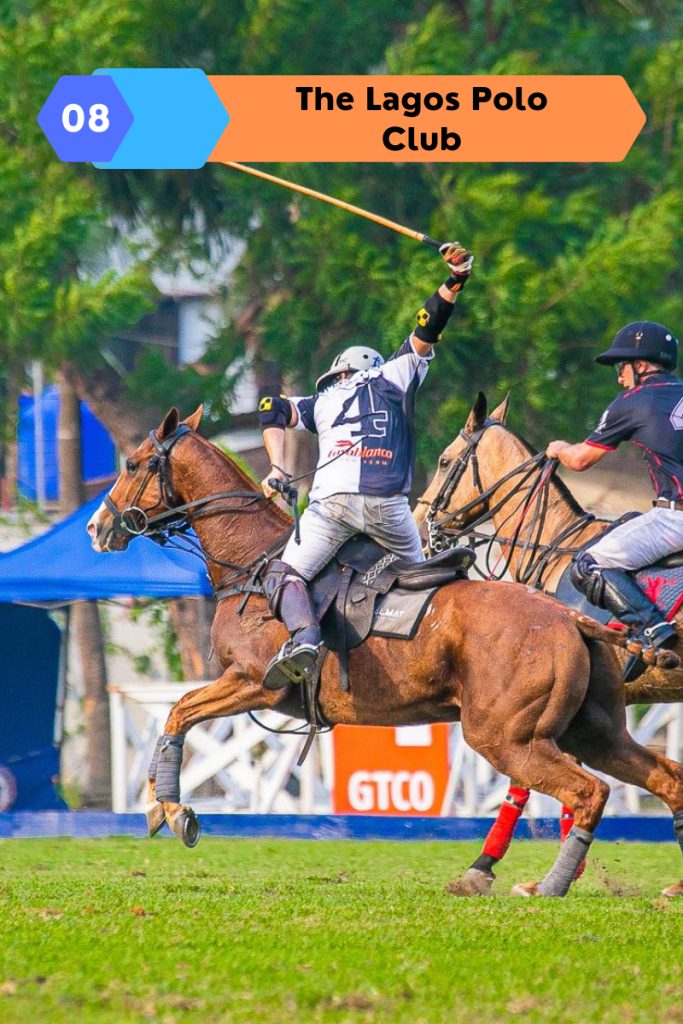
Visit the prestigious Lagos Polo Club, a luxurious and vibrant event space that promotes both leisure and sports. Think elegant décor, outdoor parties and exceptional frames of cultural challenges such as swimming carnivals, billiard tournaments, polo events and more. The Lagos Polo Club also offers buggy rides, paintball games and other fun activities for family members looking to explore together.
F.A.Q about Lagos Polo Club
Is the Lagos Polo Club open to the public?
The Lagos Polo Club is a private club and is generally not open to the public. Membership is typically by invitation only, although the club may occasionally host events or activities that are open to the public.
Are there any facilities available at the Lagos Polo Club, such as a restaurant or bar?
Yes, the Lagos Polo Club typically has facilities available for members and guests, such as a restaurant or bar. The specific amenities and services available may vary depending on the time of year and the availability of events and activities.
Does the Lagos Polo Club offer Polo lessons or instruction?
Yes, the Lagos Polo Club often offers lessons and instruction for people who are interested in learning to play polo. These lessons are typically led by experienced instructors and are designed to help beginners learn the basics of the sport.
Are there any dress code requirements for events at the Lagos Polo Club?
Yes, the Lagos Polo Club typically has dress code requirements for events and activities at the club. hese requirements may vary depending on the specific event and the nature of the event, but generally, smart casual or semi-formal attire is expected
9) National Arts Theatre

The National Arts Theatre is a cultural and entertainment venue located in Lagos, Nigeria. It was built in 1977 and is known for its unique architectural design, which includes a large dome that sits atop the building. The National Arts Theatre hosts a variety of events, including concerts, plays, exhibitions, and conferences. It is also home to the National Troupe of Nigeria, a group of performers who present traditional and contemporary Nigerian music, dance, and drama.
In addition to its cultural significance, the National Arts Theatre is also a landmark in Lagos. Its unique design and central location make it a popular spot for visitors to take photos and learn more about the city’s history and culture.
F.A.Q about National Arts Theatre
What are the hours of operation for the National Arts Theatre?
The National Arts Theatre is open daily, although the specific hours of operation may vary depending on the time of year and the availability of events and performances.
Who designed the National Theatre Lagos?
The National Arts Theatre in Lagos, Nigeria was designed by an architect named John Elliott. The theatre was completed in 1976 and features a modernist design with a distinctive spherical dome that is visible from a distance. The theatre is located in the city’s cultural center and is considered an important cultural and entertainment venue in Nigeria.
When was the National Arts theatre built?
The National Arts Theatre in Lagos, Nigeria was completed in 1976
10) Tinubu Square
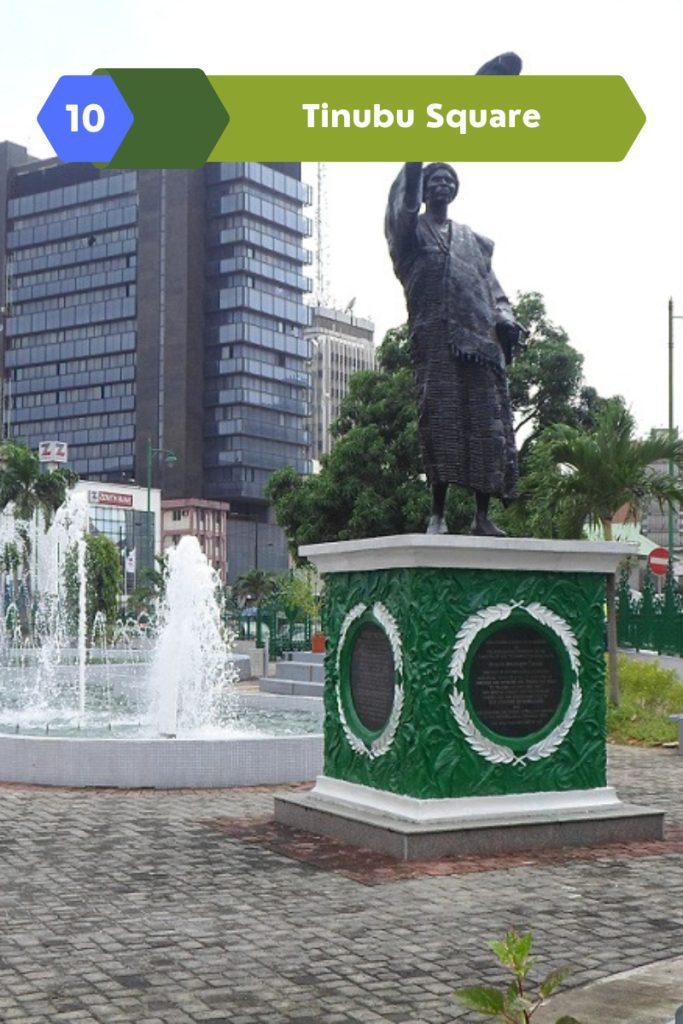
Tinubu Square is an iconic symbol of the city and a major tourist attraction in Lagos. Located at the corner of Broad Street and Martins Street, it is renowned for its hustle and bustle. It is commonly referred to as the “Isale Eko’’ or ‘The Market by the Sea`, with stalls selling jewellery, artefacts, exquisite carvings, fabrics, shoes and more. The market is also known for its vibrant street food – be sure to sample some classic Nigerian cuisine during your visit!
F.A.Q about National Arts Theatre
When was Tinubu Square built?
The National Arts Theatre is open daily, although the specific hours of operation may vary depending on the time of year and the availability of events and performances.
Who is Tinubu Square named after?
Tinubu Square in Lagos, Nigeria is named after Madam Efunroye Tinubu, also known as Madam Tinubu. Madam Tinubu was a powerful and influential figure in the history of Lagos, and was known for her political and business acumen. She was a Yoruba leader and played a significant role in the development of the city.
Conclusion
In conclusion, Lagos is a city that is bursting with culture, history, and entertainment. From the historic Lagos Island to the modern Eko Atlantic City, there is no shortage of must-visit tourist attractions in the city. Whether you’re interested in art, music, history, or just want to relax on a beautiful beach, Lagos has something to offer. So, if you’re planning a trip to Nigeria, be sure to add these top tourist attractions in Lagos to your itinerary. You won’t be disappointed by the rich cultural experiences and unforgettable memories that the city has to offer.
